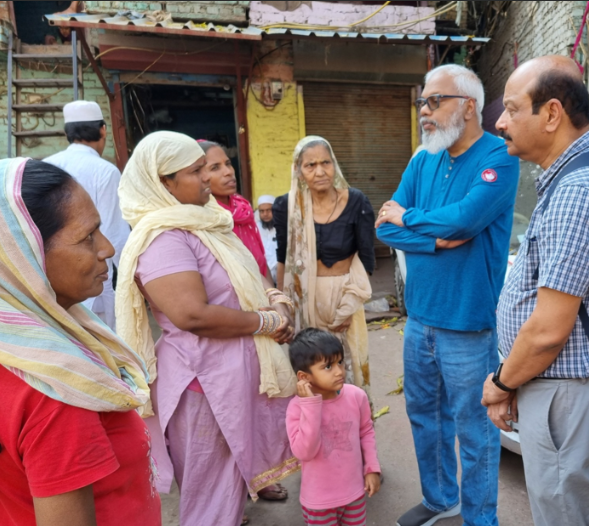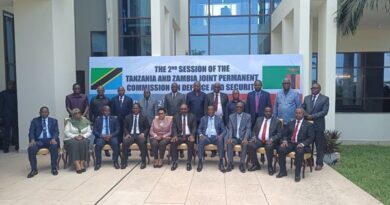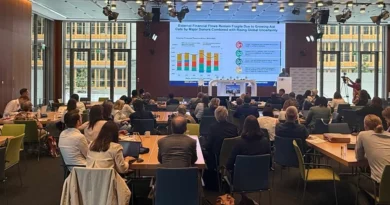How Can We Leave Behind Those at Higher Risk of TB?
When even one person dies of tuberculosis (TB) — despite the availability of world-class diagnostics and treatment in India — it is a failure of the system. In 2023 alone, TB claimed over 1.25 million lives globally, according to the WHO Global TB Report 2024. Every TB death underlines the urgent need for stronger, community-focused interventions that reach those most at risk.
In the heart of India’s national capital, Delhi, a female migrant worker living in a slum lost both her children to TB. Yet, her story didn’t end there. Supported by community-led initiatives, she now helps others detect and treat TB early, preventing further tragedy.
“If people face barriers in accessing services, then public services must go to them,” said Dr. Sreenivas Achuthan Nair, Senior Advisor at the Stop TB Partnership, during his visit to Delhi. A veteran of over 25 years in strengthening TB responses, Dr. Nair emphasized the need for a people-centered, rights-based, and gender-transformative approach to TB care.
Technological advancements — many developed in India — mean there are no excuses for not bringing healthcare directly to vulnerable communities. Integrated responses that address hunger, poverty, malnutrition, non-communicable diseases (NCDs), tobacco and alcohol use, and AIDS are crucial for effectively ending TB, aligning with the UN Sustainable Development Goals (SDGs).
In Delhi, frontline workers known as TB Affected Street Activists (TASAs) — most of them TB survivors — work with homeless and migrant women through the Humana People to People India initiative. Funded by the Stop TB Partnership’s Challenge Facility For Civil Society Grant, twenty TASAs, supported by over 100 ‘Sahelis’ (female friends), are creating a powerful grassroots network to tackle TB head-on.
Dr. Nair visited shelter homes with TASAs like Chanda and Geeta, their coordinator Ravindra, and other Sahelis. Despite living only a kilometer away from major public health facilities like the Jhandewala TB clinic, barriers like stigma, lack of documentation, and daily survival challenges make healthcare access nearly impossible for the homeless and migrant communities without active support.
Former TB survivor Jahangir Alam and community leader Subrat Mohanty from Humana People to People India accompanied Dr. Nair, showcasing how community-driven approaches dramatically improve TB detection, treatment, and follow-up.
TASAs don’t just guide patients to testing and treatment; they help marginalized people acquire vital documents like Aadhar and PAN cards, open bank accounts, and access government financial support. Under India’s Direct Benefit Transfer program, TB patients receive INR 1000 monthly during treatment — essential for those who otherwise face catastrophic health expenses.
One homeless woman shared that she received INR 3000 so far, thanks to the support of TASA Chanda. Others highlighted how regular health camps, X-Ray screenings through mobile vans, and peer education meetings have been life-changing.
Maya, another Saheli, explained how their slum’s demolition last year pushed them into even harsher living conditions, worsening vulnerabilities like child dropout from school and addiction. Yet, their group remains resilient, continuing to support one another in seeking timely TB care and advocating for community health.
Dr. Nair praised India’s innovative 100 Days Campaign, launched on December 7, 2024, to screen key and vulnerable populations proactively using ultraportable handheld AI-enabled X-Ray units and offering molecular tests. Operating across more than half of India’s districts, this approach aims to find both symptomatic and asymptomatic TB cases early.
Data from India’s National TB Prevalence Survey (2019–2021) showed that nearly half of TB cases were found via X-Ray in patients without symptoms, reinforcing the need for such proactive screening.
The campaign ends on March 24, 2025, aligning with World TB Day, whose global theme is “Yes! We Can End TB: Commit, Invest, Deliver.” It’s a rallying cry for urgent action, hope, and accountability — and in Delhi’s slums and streets, it’s already becoming reality.
At the India Innovation Summit in Delhi, attended by over 900 participants, more than 300 India-made innovations to prevent, detect, and treat TB were showcased. These innovations — from AI-enabled diagnostics to community mobilization models — reflect India’s leadership and commitment to bending the TB curve.
Dr. Nair reiterated that alongside medical advances, achieving SDG targets like zero hunger and zero poverty is vital to ending TB, especially for those most likely to be left behind.



